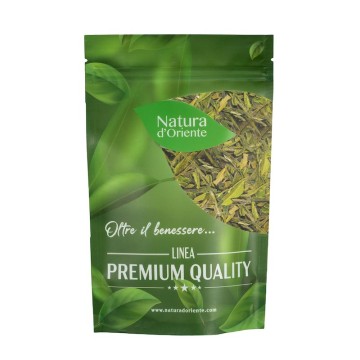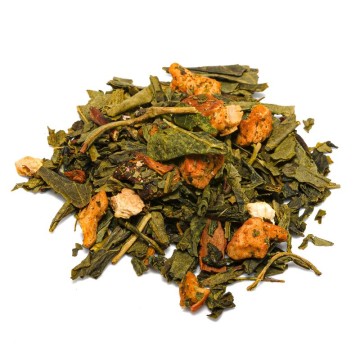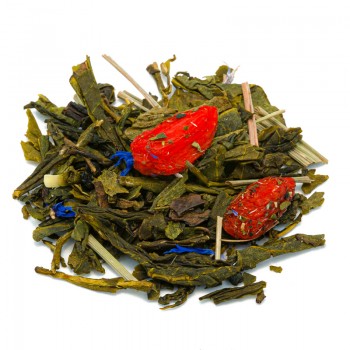This infusion is also known as Long Jin tea and Dragon's Well tea (the well of the Dragon that supplied the best water for the preparation of this Chinese green tea. It is a variety produced in the province of Zhejiang. It is one of the most loved Chinese green teas, and in the 17th century it was also "Gong Cha", i.e. an imperial tea. Its fame is due to its four qualities, historically defined as "four treasures": a bright green colour, an intense aroma, a full flavor and a beautiful shape.
Its flavor is full and velvety, slightly astringent, with a sweetness reminiscent of notes of lightly toasted chestnuts, nuts, and a lingering finish. The aroma evokes freshly cut grass and vanilla.
This special Chinese tea shows a light yellow color, rather than yellow-green like most similar teas.
It is obviously a high quality green tea, which is born from a hand process, with a gentle fire drying made with metal pans. In this way the leaves fold back on themselves and take on the characteristic sword shape (the beautiful shape).
This delicate cooking in a pan has the same function as roasting, namely to prevent fermentation, due to the natural enzymes present in the tea leaves. The process prevents the oxidation of the chemicals contained in the leaves, including vitamin C and polyphenol antioxidants called catechins. The healthy properties of this green tea also derive from this process.
Properties and benefits of Lung Ching green tea
The benefits of Lung Chin tea have been well known in Chinese medicine for centuries, while contemporary research has highlighted the substances that cause them.
The catechins contained in this green tea are antioxidants that help the human body deal with other chemicals called free radicals, which interact with cell DNA and increase health risks , aging and cellular damage.
In traditional Chinese medicine, Lung Chin tea has a stimulating, diuretic and digestive aid function. Contains many tannins, astringent components with great antidiarrheal and purifying properties. They combine with the proteins of the mucous membrane, preventing the growth of harmful intestinal bacteria.
It is also used as a diuretic to remove excess body fluids, in cases of water retention.
It has the ability to improve attention and promote concentration, thanks to the contained theine / caffeine. It is a sought-after tea for its high level of caffeine, which also helps soothe headaches and counteract low blood pressure.
Caffeine is balanced by the amino acid L-theanine, a known natural sedative substance contained in tea leaves.
As green tea, Lung Chin is a source of vitamin C and antioxidants, retained in the tea thanks to roasting, in large pots or woks, which takes place immediately after harvesting. By stopping the oxidation process, it preserves a very high concentration of catechins and other polyphenolic compounds.
It is also recommended in slimming diets, as green tea which stimulates the metabolism and increases energy levels, thanks to caffeine (theine) as a stimulant. Combined with a correct diet, it can help burn excess fat thanks to the catechins, which have a thermogenic effect. They increase body temperature, activating metabolism, energy expenditure and burning of body fat.
It is a delicate and fragrant tea, useful for the well-being of the oral cavity and for eliminating bad breath.
Origins and History of cultivation
Lung Ching tea or Longjing (Dragon Well) takes its name from the village of Lung Ching, in the Hangzhou area - Zhejiang province.
The area is important because its history stems from a legend from the 3rd century AD, according to which a Taoist priest, during a drought, invited the villagers to pray to a dragon that he lived in a nearby well, so that it would bring more water. The source of the well was believed to be connected to an underground sea. When the rain came, putting an end to the famine, the well took the name of the Dragon, in honor of him, and a beneficial tea was prepared with its water.
The legend naderives from the fact that the dense well water, after the rain, collects the lighter rainwater. It floats on the surface, and together with the internal currents, creates a sinuous movement that resembles that of a Chinese dragon. The plantations of this green tea, however, have been present since the Tang dynasty, for over 1200 years; the most valuable crop is known, from the cultivations around Mount Shi Feng known as Lion's Peak.
The Lung Ching was later granted the status of Gong Cha, or imperial tea, by the Kangxi Emperor (1661-1722). He discovered a delicate tea with a refined scent which, according to another legend, also demonstrated beneficial properties such as to improve the mother's health. The imperial tea was derived from the leaves of 18 trees, still planted in Hu Gong Temple today, and the tea produced from them is sold at incredibly high prices.
Lung Ching, therefore, is one of the most famous teas in China, which was also produced in other areas of Zhejiang: in addition to the mountain, Shi Feng was present in the Mei Jia area Wu, Weng Jia Mountain, Yun Qi area, and Hu Pao area.
Tea can only be qualified as Lung Ching if it must be produced within a well-defined area, the Protected Area. It is an Chinese tea because it must be produced according to the traditional style of hand-picking and typical processing.
There are different categories of Lung Ching: Mei Jia Wu, Xi Hu, Zhejiang Longjing and Shi Feng – the prized Lung Ching tea produced on the mountain.
The limited production makes it a rarer than usual Chinese tea, created with the pan-cooking process of the leaves, which requires skill and time. For its preparation, traditionally the best tea is the one that uses water from the Hangzhou spring called Hupao, "tiger's dream", which flows from quartzite rocks.
Plant and flowers
The Camellia sinensis, tea plant, is a woody and perennial evergreen belonging to the genus Camellia of the Theaceae family.
It is cultivated to obtain the leaves, which, depending on the processing, are transformed into green, white and black tea. The plant prefers woodland soil, but also thrives in warm, well-drained soil, preferably with a pH between 5 and 7.
The shrub can grow up to 9 meters in height, but is generally pruned and kept low for manual leaf picking.
It prefers the partial shade of a forest or a clearing, and tolerates average temperatures - it is not very resistant in cold areas. It prefers humid summers and cool but not very freezing winters, which is why it originally developed in various Asian territories and in Southeast Asia. Today it is cultivated in tropical and warm temperate areas. The fragrant, white flowers are very attractive to insects, producing few seeds.
Nutritional values of Lung Ching green tea
The main components of this tea are several antioxidants or nutritional substances, such as the amino acids theanine and arginine. It also contains ascorbic acid (vitamin C), vitamin B, caffeic, chlorogenic, and malic acids. In addition to good quantities of alkaloids, such as caffeine and theobromine.
Contains important polyphenols such as antioxidant catechins (epicatechin-gallate, epigallocatechin-gallate), and small quantities of mineral salts (sulphur, calcium, copper, iron, magnesium, phosphorus, potassium ).
How to prepare Lung Ching green tea
The tea is obtained by placing in a cup (250 ml), about 3-5 grams of the infusion preparation with the Lung Ching leaves. Water at a temperature of 80 °C.
Leave it to infuse for 2 to 3 minutes, before drinking the green tea infusion.
Lung Ching green tea: side effects and contraindications
Green tea, if used regularly, does not present particular risks but some contraindications and side effects that should be taken into account.
For this reason, it is good to respect the recommended doses, avoiding that the caffeine contained in Lung Ching green tea can cause undesirable effects. Taking too much theine / caffeine can lead to restlessness, anxiety, nervousness, stomach problems, rapid heart beats.
In addition, tea contains catechins which, in high quantities, could reduce the body's ability to absorb iron from foodnts; for those suffering from anemia and iron deficiency it is good to pay attention to the excessive intake of green tea.
Caution is advised when taking the infusion even for pregnant and breastfeeding women.









 No reward points for this product.
No reward points for this product.

![Green Tea Choui Fong Tea [Natura d'Oriente]](https://www.naturadoriente.com/3379-home_default/green-tea-choui-fong-tea.jpg)


![Green tea with orange and grapefruit [Natura d'Oriente]](https://www.naturadoriente.com/3376-home_default/green-tea-with-orange-and-grapefruit.jpg)

![Green Tea Ceylon Melfort Special [Natura d'Oriente]](https://www.naturadoriente.com/3378-home_default/-green-tea-ceylon-melfort-special-.jpg)




![green tea hemp mango [Natura d'Oriente]](https://www.naturadoriente.com/3381-home_default/green-tea-mango.jpg)



